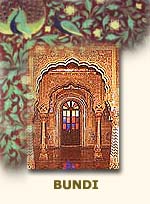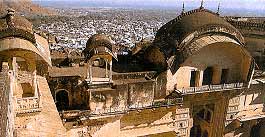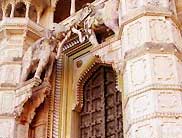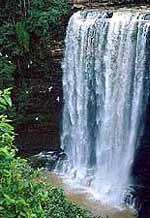 Bundi and Kota were once a singly principality ruled by the Hada Chauhans, an offshoot of the famous clan of Chauhans who ruled Delhi and Ajmer.After the defeat of Prithviraj Chauhan by Sultan Mohammed Ghori in 1193, the Chauhan nobles sought sanctuary in Mewar. They were welcomed and proved allies to the Rana.Yet some young warriors ventured on their own overpowered the Meena and Bhil Tribals of Chambal valley and established the kingdom of Hadavati or Hadoti. Later two branches of the Hadas formed two separate states on either sides of the Chambal. These were Kota and Bundi. Bundi town nestles in a narrow valley, enclosed by huge walls and fortified by four gateways.In the centre of the township lies a lake. A medieval fortress stands sentinel to this city – amute witness to history and time.
Bundi and Kota were once a singly principality ruled by the Hada Chauhans, an offshoot of the famous clan of Chauhans who ruled Delhi and Ajmer.After the defeat of Prithviraj Chauhan by Sultan Mohammed Ghori in 1193, the Chauhan nobles sought sanctuary in Mewar. They were welcomed and proved allies to the Rana.Yet some young warriors ventured on their own overpowered the Meena and Bhil Tribals of Chambal valley and established the kingdom of Hadavati or Hadoti. Later two branches of the Hadas formed two separate states on either sides of the Chambal. These were Kota and Bundi. Bundi town nestles in a narrow valley, enclosed by huge walls and fortified by four gateways.In the centre of the township lies a lake. A medieval fortress stands sentinel to this city – amute witness to history and time.
Bundi is famous for its intricate paintings and murals.Bundi lies embraced by hills, the capital of the Hada Rajputs who established their craggy stronghold in these forested hills, but fate and the forces of power created Kotah, a breakaway part of Bundi that went on to become larger and more powerful than its parent state.
PRIME SITES
 Taragarh fort : The town’s Rajput legacy is well preserved in the shape of the massive Taragarh fort ( it is also known as Star Fort )which broods over the town in the narrow valley below and the huge palace which stands beneath it. This Fort was built in 1354. It is reached by a steep road leading up the hill side to its enormous gateway, topped by rampant elephants. Inside are huge reservoirs carved out of solid rock and the Bhim Burj, the largest of the battlements, on which is mounted a famous cannon. Views over the town and surrounding countryside are excellent. The Palace is one of the finest examples of Rajput architecture. It is massed across a rocky height , approached by a road of stone steps and ramps meant for horsemen and chariots. Here, the Chitra Mahal is an absolute delight. In a gallery built around a sunken court open to the sky, there are beautiful murals done in the Bundi style of miniature paintings. Above the palace, accessed through the impressive Elephant Gate are the royal apartments, murals, balconies, corbels, pavilions, fretted windows, domes.Sunset dusts the memorial pavilions, or Chhatris, of the former rulers with gold. This quiet place is set in a grove of old trees and the high platforms of the memorials are decorated with horses and elephants.Bundi has a couple of beautiful baoris (step wells) right in the centre of town.
Taragarh fort : The town’s Rajput legacy is well preserved in the shape of the massive Taragarh fort ( it is also known as Star Fort )which broods over the town in the narrow valley below and the huge palace which stands beneath it. This Fort was built in 1354. It is reached by a steep road leading up the hill side to its enormous gateway, topped by rampant elephants. Inside are huge reservoirs carved out of solid rock and the Bhim Burj, the largest of the battlements, on which is mounted a famous cannon. Views over the town and surrounding countryside are excellent. The Palace is one of the finest examples of Rajput architecture. It is massed across a rocky height , approached by a road of stone steps and ramps meant for horsemen and chariots. Here, the Chitra Mahal is an absolute delight. In a gallery built around a sunken court open to the sky, there are beautiful murals done in the Bundi style of miniature paintings. Above the palace, accessed through the impressive Elephant Gate are the royal apartments, murals, balconies, corbels, pavilions, fretted windows, domes.Sunset dusts the memorial pavilions, or Chhatris, of the former rulers with gold. This quiet place is set in a grove of old trees and the high platforms of the memorials are decorated with horses and elephants.Bundi has a couple of beautiful baoris (step wells) right in the centre of town.
 Tara Garh Palace : A complex of various palaces, built by rulers of different times. Hugging the steep hillside, the complex looks like a checkerboard when viewed from above. This magnificent structure is a fine example of the Rajput architecture housing some of the superb Bundi landscape including Chitrashala, a fascinating pavilion and a gallery of miniature murals embellish the palace.
Tara Garh Palace : A complex of various palaces, built by rulers of different times. Hugging the steep hillside, the complex looks like a checkerboard when viewed from above. This magnificent structure is a fine example of the Rajput architecture housing some of the superb Bundi landscape including Chitrashala, a fascinating pavilion and a gallery of miniature murals embellish the palace.
Rani Ji Ki Baori : Right in the centre of the town are a couple of extremely awe-inspiring baoris or step wells. The largest of its kind, is 46 mts deep and endowed with intricate carvings. Built in 1699 by Rani Nathavatji, the steps leading down to the water are framed with soaring pillars. Panels, depicting images displaying animal-human evolution, have been carved in the images of avatars.Largest of its kind, with beautifully carved walls and pillars and the high arched gate is this stepwell of the Bundi queen, who took baths here at religious occasions.
Chaurasi Khambo ki Chhatri : This 84-pillared cenotaph was raised in the memory of Deva, the son of the wet nurse of Rao Raja Anirudh Singh. Built on a high platform this unique double story cenotaph has a large Shivlinga at the center, which makes it both a temple as well as a cenotaph.

Chitrashala : A beautiful pavilion and gallery of fascinating murals in the miniature style. The walls areadorned with elaborate painting depicting scenes from the Ragmala and Raslila, the Radha-Krishna legends. The colour scheme of all these paintings is blue, green, turquoise on white with touches of terracotta or yellow. Bundi Wall paintings are famous all over the world.
Chatra Mahal, Ratan Daulat & Badal Mahal : These palaces are part of Garh Palace. The main attraction is rooms and galleries full of murals of Bundi Miniature Paintings. The colour schemes of these paintings are red, golden and blue. Although these palaces are private property of the Maharaja and are not open for public. But any body can visit these places with the help of Maharaja’s staff.
Sukh Mahal : Means Palace of bliss where Rudyard Kipling stayed when he visited Bundi in late 19th Century. This magnificent summer palace was constructed during the reign of Rao Raja Vishnu Singh. It is said that an underground tunnel runs from Sukh Mahal to Taragarh Fort.
Hunting Lodge: It was royal hunting lodge. Nestled in the woods amidst lush greenery, it is a beautiful picnic spot.The Rajputana of yore, set amidst the great Thar, the only desert of the sub-continent, is known not only for the sizzling heat and the dunes but also for the warmth in the hearts of the people. Considered as the most colourful region of India , this exotic land of valiance and chivalry has an unusual diversity in all its forms, people, customs, culture, costumes, music, manners, dialects, and cuisine etc. It is the land of superlatives, everything here is breathtakingly beautiful, impressive and fascinating. Rajasthan is endowed with invincible forts, magnificent palaces and havelis. We will confine ourselves only with the southern Rajasthan – The Hadoti region that is BUNDI, the least explored land of Rajasthan. The Remote but fascinating town of Bundi deserves more than a short visit. It is reputed among the tourists for its palaces, step wells and water tanks. Countless monuments spread the city reflects the peaks of the architectural excellence achieved during the days of yore. The huge frescos depicting the glory of Rajput rulers are the special attractions.
 Menal : In the middle of beautifully wooded revives is a gorge of the Menal river and the ruins of what used to be the mountain retreat of thegreat Raja Prithviraj Chauhan. On the banks of river are the ruins of an ancient palace and a complex of beautiful temples dating 12th century. The waterfalls here are in stark contrast of the image one usually holds of Rajasthan Haveli Braj Bhushanjee invites you to explore the rich heritage and culture of BUNDI. Your every moment will be caught and held in its history. Bundi is a dream remembered. Nestling at the footsteps of a large craggy hill, Bundi, named after Bunda Meena, was established by Rao Deva in 1241 A.D. The large dominating complex of fort and palaces, hugging the steep hillside, is mainly made of two- Garh-Palace and Taragarh-Fort.
Menal : In the middle of beautifully wooded revives is a gorge of the Menal river and the ruins of what used to be the mountain retreat of thegreat Raja Prithviraj Chauhan. On the banks of river are the ruins of an ancient palace and a complex of beautiful temples dating 12th century. The waterfalls here are in stark contrast of the image one usually holds of Rajasthan Haveli Braj Bhushanjee invites you to explore the rich heritage and culture of BUNDI. Your every moment will be caught and held in its history. Bundi is a dream remembered. Nestling at the footsteps of a large craggy hill, Bundi, named after Bunda Meena, was established by Rao Deva in 1241 A.D. The large dominating complex of fort and palaces, hugging the steep hillside, is mainly made of two- Garh-Palace and Taragarh-Fort.
Jait Sagar Lake (3 km): A picturesque lake cradled in the hills, built by Jaita Meena. The swirling fountain at night is a visual delight.
Rameshwaram (20 km):The cave temple of Lord Shiva surrounded by the Aravalli ranges. An ideal picnic spot as well.
Keshavraipatan (45 km.): It is an ancient city famous for the temple of Keshavraiji (Vishnu). The architecture and sculpture at this temple is unique. It was constructed in the year 1601 A.D. by Maharaja Shatrusal of Bundi. A famous Jain temple is also there.
Ramgarh (45 km):The Ramgarh Sanctuary is located on the Nainwa road. One needs to take permission for the State Forest Department prior to a visit to the sanctuary.
Bijolia(50 km): An ancient fort and the city of Bijolia is situated on the Bundi Chittaurgarh road. On the side of the fort is a large temple of Lord Shiva in its center with a fine image of Lord Ganesha standing as a guardian at the entrance. A carved archway leads to the temple.
Nawal Sagar: Visible from the fort is the square artificial lake of Nawal Sagar, broken up by islets. A temple dedicated to Varuna, the Aryan god of water, stands half submerged in the center of the lake. The reflection of the entire city and its palaces can be seen in the lake – making it a unique attraction of Bundi
Talwas (53 km):A magnificent fort built by the ruler Ajit Singh. A temple of Dhooleshwar Mahadev and a picturesque water adjoining the fort are worth a visit. The beautiful Ratna Sagar Lake is close by and it’s a haven for fauna like bear and deer during the monsoon.
Dugari (65 km): Remnants of ancient wall paintings can be seen in the Ram Mandir within the imposing fort of Dugari.
Indragarh (77 km):The Indragarh Fort and the nearby palaces are famous for the temples of Mother Goddess Kali and Kamleshwar. The palace is also famous for wall paintings.